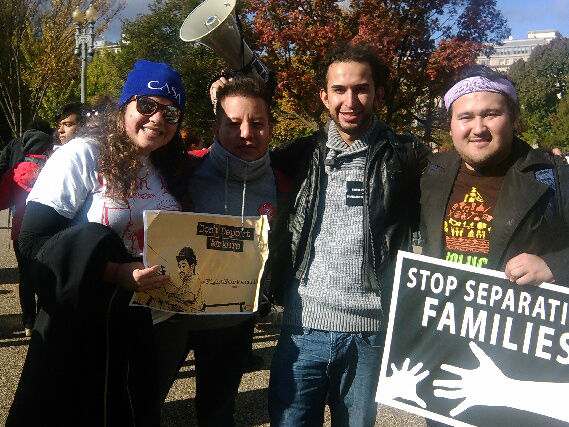
Junior chemical engineering major Jorge Steven Acuña left Colombia to come to this country when he was 8 years old. Now, the 21-year-old from Germantown considers this state his home, but the road has not been easy for him as an undocumented immigrant.
On a Wednesday morning in March 2012, U.S. Immigration and Customs Enforcement agents showed up at Acuña’s door. They arrested his father before placing the rest of the family in the maximum-security block at a holding facility on the Eastern Shore.
My dad and I, we were terrified, we didn’t really know what to expect,” he said.
On the sixth day, ICE released Acuña and his family in response to the growing pressure from politicians and petitions and granted them one-year reprieve. Acuña then applied for the newly enacted Deferred Action for Childhood Arrivals program, which gave him legal status for two years.
The executive action President Barack Obama announced Nov. 20 expanded DACA, allowing more immigrants like Acuña to stay in this country without fear of deportation. It also extended Acuña’s temporary stay from two to three years between renewals, but with his parents still facing possible deportation and his legal status uncertain, Acuña and other immigrant students said the action did not go far enough.
Acuña, now in his first year at this university, attends under the Maryland Dream Act, which allows undocumented high school graduates to receive in-state tuition at public universities in the state.
There are 34 undergraduate Dream Act students attending this university, according to the Office of Institutional Research, Planning, and Assessment. In addition, there are between 50 and 60 undocumented students benefiting from DACA who did not qualify for the Dream Act, according to Yvette Lerma, coordinator for Latina/o Student Involvement and Advocacy.
But this number still does not account for all of the undocumented students on the campus, said Janelle Wong, Asian American Studies Program director, who works with Dream Act students. Wong said she has spoken with undocumented students who are neither DACA nor Dream Act beneficiaries and live with the fear of deportation.
These students also face greater financial pressure because they must pay out-of-state tuition and are not eligible for financial aid because of their undocumented status, Lerma said.
“There are still individuals that don’t fall into those categories that are even more invisible and feel left behind because of it,” Lerma said. “So there’s a level of financial stress, the fear of deportation and the mental health piece of feeling isolated and not having the support.”
Lerma started a group called UndocuTERPS for faculty and staff to learn how to support undocumented students on the campus. She hopes to create a greater community of students who can feel comfortable sharing their stories with others.
“They just cannot get in any trouble,” Wong said. “The fact is, most students in college might engage in activities, drinking before they’re 21 and various other things they consider casual fun, but for these students it’s a matter of being able to stay in the country.”
A misdemeanor charge, even as small as a noise violation, could mean deportation for a whole family, Wong said.
Students in the DACA program also worry that their status is only temporary, and that DACA could be overturned by a new presidential administration. Obama implemented the program in 2012 after the federal DREAM Act failed.
Yves Gomes, a DACA and Dream Act student at this university from India, came to the country with his parents when he was one year old.
After the family’s original tourist visas expired, a 12-year legal struggle to gain permanent status ensued, which later fell through and left the family undocumented. Gomes finished high school with a temporary stay from Homeland Security.
“The process itself isn’t a good process to begin with,” said Gomes, who plans to graduate at the end of this semester with a bachelor’s degree in biochemistry. “It’s a very bureaucratic process.”
Acuña said the most tangible impact Obama’s Nov. 20 executive action will have on his life is the extended term between DACA renewals — temporary legal status now spans three years instead of two, saving Acuña about $500 in fees.
Obama’s action gave deportation relief to about 3.9 million additional undocumented immigrants, according to the Pew Research Center, bringing the total eligible for relief to 5.4 million.
About 5.8 million undocumented immigrants in this country are not eligible for relief, and DACA extension only protects students, not their families.
Acuña, who works part-time as a bartender to pay for school and commutes from home to save money, said he worries about losing his family. Acuña’s parents have a temporary stay, but their future depends on whether ICE grants them another extension at the start of 2015.
This fear is also a reality for Gomes, who now lives with a great-uncle in Silver Spring. He said his parents are banned from the United States until 2019, and he is skeptical of the executive action.
José Granados, a senior Spanish major, moved to the U.S. from El Salvador when he was 11. After his visa expired, Granados and his family were undocumented for two years while they applied for permanent residence.
“I just found it really unfair that during that two-year period I couldn’t leave the country,” Granados said. “I was in quarantine.”
A lengthy legal process allowed Granados’ mother to receive permanent residence for her two sons in 2007, but Granados said the process cost her about $14,000.
“I’m more than just a number; I am more than just a good,” Granados said. “As an immigrant, we are more than just a price tag, and I think that’s what a pathway to citizenship is now in this economy.”



